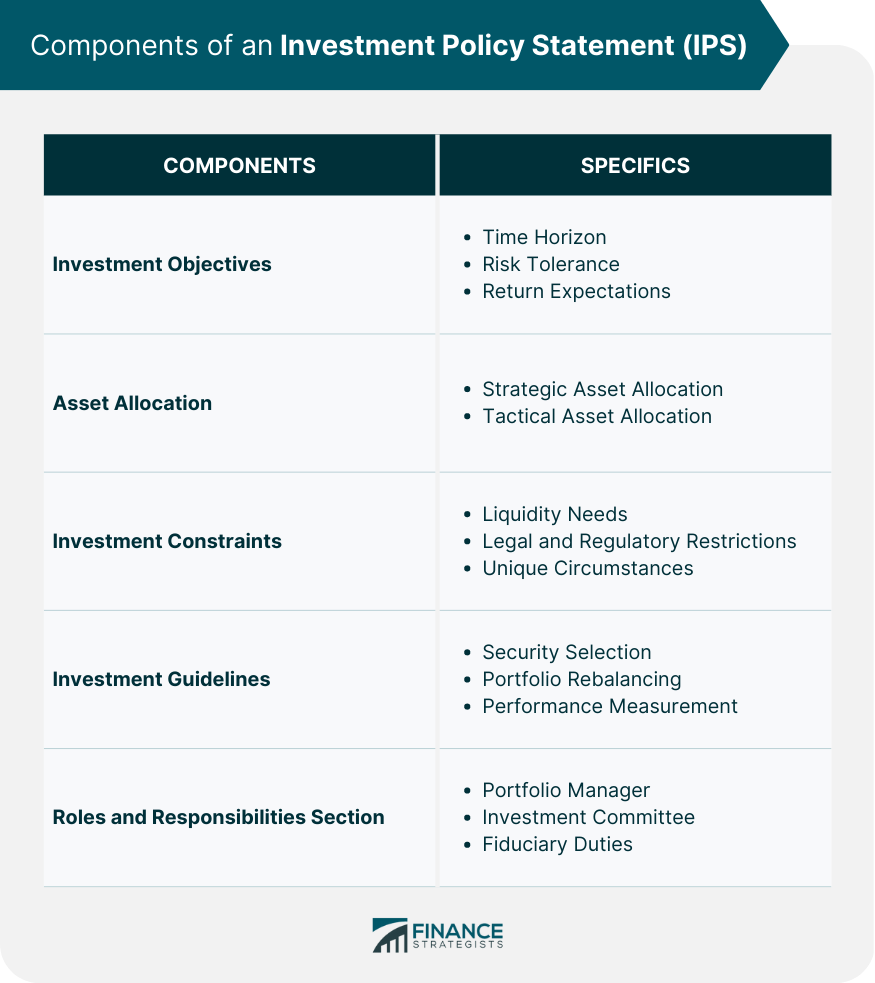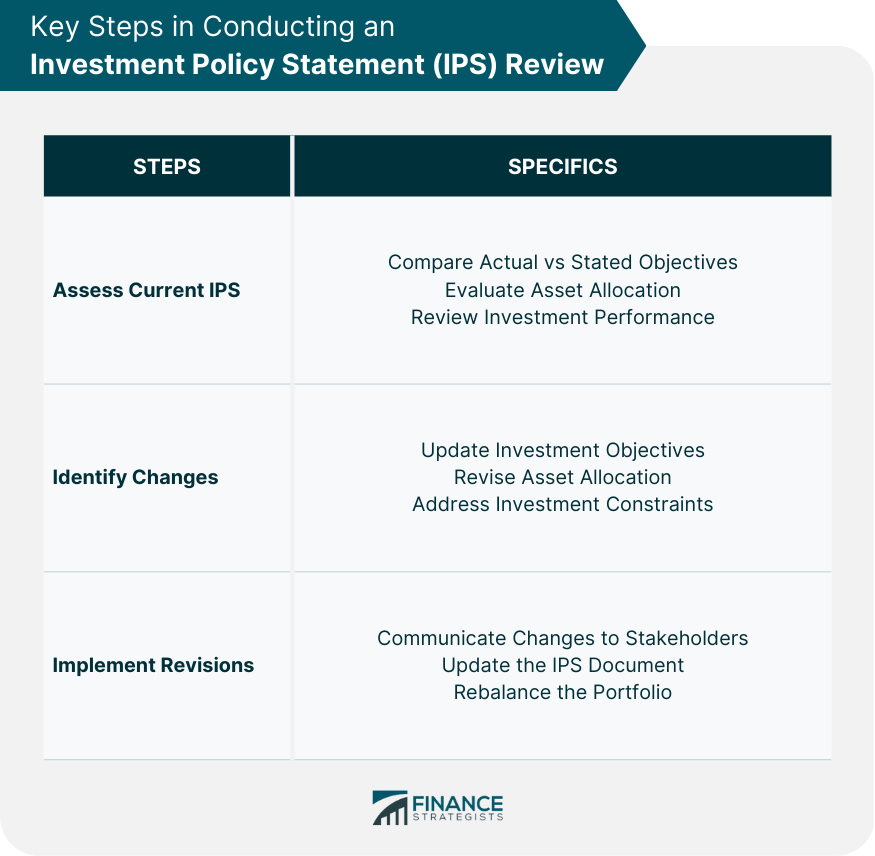Regular Investment Policy Statement (IPS) reviews are essential to ensure that the document remains relevant and up-to-date, reflecting any changes in the investor's financial situation, goals, or market conditions. An Investment Policy Statement is a written document that outlines an investor's investment objectives, risk tolerance, and strategies for achieving those objectives. An IPS aims to establish a clear understanding between the investor and the investment advisor, providing a roadmap for the investor's investment strategy and management. Investment objectives are the financial goals an investor aims to achieve through their investment strategy, taking into consideration time horizon, risk tolerance, and return expectations. Time Horizon: Time horizon refers to the period an investor plans to hold their investments before needing to access the funds. Risk Tolerance: Risk tolerance is the level of risk an investor is willing to accept in pursuit of their investment objectives. Return Expectations: Return expectations are the anticipated returns on investments, considering factors such as historical performance and market conditions. Asset allocation is the process of dividing an investment portfolio among various asset classes to achieve diversification and balance risk. Strategic Asset Allocation: Strategic asset allocation is a long-term investment strategy that involves setting target allocations for various asset classes and periodically rebalancing the portfolio. Tactical Asset Allocation: Tactical asset allocation is a short-term investment strategy that involves making temporary adjustments to the portfolio's asset mix based on market conditions or opportunities. Investment constraints are factors that limit an investor's ability to achieve their investment objectives, such as liquidity needs, legal and regulatory restrictions, and unique circumstances. Liquidity Needs: Liquidity needs refer to the investor's requirement for readily accessible funds to meet short-term financial obligations. Legal and Regulatory Restrictions: Legal and regulatory restrictions are limitations imposed by laws, regulations, or other governing bodies that affect investment decisions. Unique Circumstances: Unique circumstances are specific factors or situations that influence an investor's investment strategy, such as personal values or social considerations. Investment guidelines are a set of rules and criteria that govern the management of the investment portfolio, including security selection, portfolio rebalancing, and performance measurement. Security Selection: Security selection is the process of choosing specific investments that align with the investor's objectives and risk tolerance. Portfolio Rebalancing: Portfolio rebalancing is the process of adjusting the portfolio's asset mix to maintain the desired level of diversification and risk. Performance Measurement: Performance measurement is the evaluation of the investment portfolio's performance against established benchmarks or objectives. The roles and responsibilities section of an IPS outlines the duties of the portfolio manager, investment committee, and fiduciary duties. Portfolio Manager: The portfolio manager is responsible for executing the investment strategy and managing the portfolio in accordance with the IPS. Investment Committee: The investment committee oversees the investment process and ensures adherence to the IPS. Fiduciary Duties: Fiduciary duties are the legal and ethical obligations of those entrusted with managing the investment portfolio to act in the investor's best interest. IPS reviews should be conducted periodically, typically on an annual basis, to ensure the document remains relevant and up-to-date. Triggers for IPS reviews include changes in investment objectives, changes in financial situation, and market or regulatory changes. Changes in Investment Objectives: A review of the IPS may be triggered when an investor's investment objectives change, such as a shift in priorities or new financial goals. Changes in Financial Situation: Significant changes in an investor's financial situation, such as job loss, inheritance, or retirement, may necessitate an IPS review. Market or Regulatory Changes: An IPS review may be required when there are significant market developments or changes in legal and regulatory environments affecting investments. During the IPS review process, the investor, financial advisor, and investment committee each play important roles in ensuring the document remains accurate and relevant. Investor: The investor is responsible for providing up-to-date information about their financial situation, investment objectives, and risk tolerance. Financial Advisor: The financial advisor is responsible for guiding the investor through the review process and recommending any necessary changes to the IPS. Investment Committee: The investment committee is responsible for overseeing the IPS review process and ensuring that any proposed changes align with the investor's goals and risk tolerance. The first step in conducting an IPS review is to assess the current IPS by comparing actual vs. stated objectives, evaluating asset allocation, and reviewing investment performance. Compare Actual vs Stated Objectives: This involves evaluating whether the investor's current portfolio aligns with the stated objectives in the IPS. Evaluate Asset Allocation: Reviewing the portfolio's current asset allocation helps determine whether it still aligns with the investor's objectives and risk tolerance. Review Investment Performance: Analyzing the portfolio's performance against established benchmarks and objectives provides insight into the effectiveness of the current investment strategy. After assessing the current IPS, the next step is to identify any necessary changes, including updating investment objectives, revising asset allocation, and addressing investment constraints. Update Investment Objectives: Updating investment objectives ensures the IPS remains aligned with the investor's current financial goals and priorities. Revise Asset Allocation: Revising the asset allocation may be necessary to maintain diversification, manage risk, or respond to changes in market conditions. Address Investment Constraints: Addressing investment constraints involves updating the IPS to reflect any changes in liquidity needs, legal and regulatory restrictions, or unique circumstances affecting the investor. Once changes have been identified, the final step is to implement the revisions by communicating changes to stakeholders, updating the IPS document, and rebalancing the portfolio. Communicate Changes to Stakeholders: Informing stakeholders of the changes ensures all parties understand the updated investment strategy and objectives. Update the IPS Document: Updating the IPS document ensures it remains current and accurately reflects the investor's objectives, asset allocation, and investment guidelines. Rebalance the Portfolio: Rebalancing the portfolio aligns it with the updated IPS, ensuring that the investor's objectives and risk tolerance are maintained. Regularly evaluating the investment portfolio's performance against established benchmarks and objectives helps ensure the strategy remains effective and on track. Ongoing assessment of the investor's financial situation enables timely adjustments to the IPS in response to any changes in financial goals or circumstances. Conducting regular IPS reviews helps ensure the document remains relevant and up-to-date, reflecting any changes in the investor's financial situation, goals, or market conditions. An up-to-date IPS is crucial for guiding an investor's investment strategy, ensuring alignment with their financial goals and risk tolerance. A systematic IPS review process helps maintain the document's relevance, allows for timely adjustments to the investment strategy, and supports long-term investment success. Regularly reviewing and updating the IPS ensures that the investment strategy remains aligned with the investor's goals and risk tolerance, maximizing the likelihood of achieving financial objectives. Investors should consider seeking professional wealth management services to help navigate the IPS review process, ensuring that their investment strategy remains on track and tailored to their unique financial needs and goals.What Is Investment Policy Statement (IPS) Review?
Components of an Investment Policy Statement

Investment Objectives
Asset Allocation
Investment Constraints
Investment Guidelines
IPS Roles and Responsibilities Section
IPS Review Process
Roles and Responsibilities During the Review Process
Key Steps in Conducting an IPS Review

Assess Current IPS
Identify Changes
Implement Revisions
Monitoring and Ongoing Review
Periodic Performance Evaluation
Continual Assessment of Investor's Financial Situation
Regularly Scheduled IPS Reviews
Final Thoughts
Investment Policy Statement (IPS) Review FAQs
An IPS review is a regular evaluation of an investor's IPS to ensure that it reflects any changes in their financial situation, goals, or market conditions, and remains relevant and up-to-date.
An IPS includes investment objectives, asset allocation, investment constraints, investment guidelines, and roles and responsibilities.
Changes in investment objectives, changes in financial situation, and market or regulatory changes are common triggers for an IPS review.
The investor, financial advisor, and investment committee each play important roles in ensuring the document remains accurate and relevant during the review process.
The key steps in conducting an IPS review include assessing the current IPS, identifying changes, implementing revisions, monitoring and ongoing review, and regularly scheduled IPS reviews.
True Tamplin is a published author, public speaker, CEO of UpDigital, and founder of Finance Strategists.
True is a Certified Educator in Personal Finance (CEPF®), author of The Handy Financial Ratios Guide, a member of the Society for Advancing Business Editing and Writing, contributes to his financial education site, Finance Strategists, and has spoken to various financial communities such as the CFA Institute, as well as university students like his Alma mater, Biola University, where he received a bachelor of science in business and data analytics.
To learn more about True, visit his personal website or view his author profiles on Amazon, Nasdaq and Forbes.













